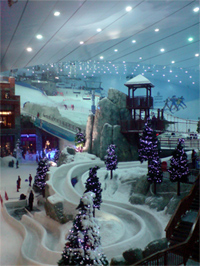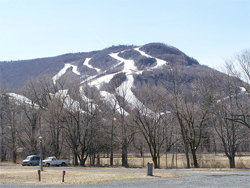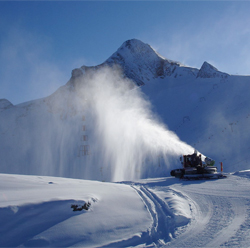When word of possible financial catastrophe came out of Dubai last week, the media scrambled for the most highly visual examples of the emirate’s opulence it could find. Luckily, these images were not in short supply. The world has watched for years, transfixed, as a golden Dubai exploded up into the sky and out beyond its natural land. As it built a ski mountain…in the desert!
It’s no surprise, then, that television viewers listened to reporters speak over images of the Burj Dubai, at 2,684 feet the tallest structure in the world. They saw aerial shots of the man-made Palm Islands that extended Dubai out into the Persian Gulf. And they watched footage of people happily cruising the slopes of Ski Dubai. The pairing of these images with news that Dubai’s government-owned investment company wanted to delay payments on $60 billion in debt struck almost an accusatory note. What did you expect, the pictures suggested. You built a ski mountain…in the desert!
A shocked reaction seems to fit the mission of Ski Dubai, even if it’s not quite in the way its planners had anticipated. I have never been, but Ski Dubai appears to be far less about the quality of the skiing, and more about the novelty of simply having such a geographically discordant experience. It has only five slopes. Fake evergreens do little to soften what otherwise looks like a giant high school gymnasium. Skiing almost feels incidental, an afterthought. In a telling design decision, the photo gallery on Ski Dubai’s Web site opens with photos of its construction.
 |
| A wintry mix in Dubai. |
For millennia, humanity was content to build its engineering marvels in concert with the land, even if that meant damming it or building over it or cutting through it. But attitudes that worked from antiquity through the 20th century wouldn’t fly in 21st-century Dubai. Anybody can work with what you’ve got: The Egyptians were doing that thousands of years ago. What was needed was something that spurned the geographical hand you were dealt. Which is why — in those halcyon days of 2005 — technology, money, and pre-collapse gusto came together to give us year-round winter sports in one of the hottest places on Earth.
This renewed interest in Ski Dubai comes at an interesting time for snow and ice in general, and the artificial stuff in particular. As for snow and ice, well, it’s disappearing. We can argue about the causes, but glaciers are retreating. Sea ice is melting. And things don’t look good for the more than 99 percent of ski resorts doomed to an outdoor existence. In September, 71 ski areas from 21 states wrote Senator Barbara Boxer — Chairman of the Senate Environment and Public Works Committee — expressing their support for a Senate version of the House American Clean Energy and Security Act.
To be sure, the resorts know that nothing will guarantee snow-filled winter months. Even if the planet never warmed, you’re still going to end up with some duds of a winter, snow-wise. What the owners seek is not solely protection of snowy conditions, but protection of the climactic conditions that allow them to produce their own. “[W]armer nights can impact our ability to make snow,” they collectively warn the Senator.
And thank goodness for the fake stuff! Ever since the owner of Mohawk Mountain in Cornwall, Connecticut chipped 500 tons of ice back in 1950 to salvage a dry January, the environment’s finicky role in skiing has been greatly diminished. That same year, three engineers came up with a snowmaking machine that debuted the following winter at Mohawk and Split Rock Lodge in Pennsylvania’s Pocono Mountains. The practice was widespread by the 1970s. In 1981, at the annual meeting for Vermont’s Killington resort, chairman of the board Joe Sargent revealed a new way of thinking about snow, thanks almost entirely to snowmaking technology. “The traditional assumption that it’s going to snow and then expressing disappointment and negative impacts when it doesn’t is a thing of the past,” he announced. In other words, why are we allowing the weather to hold us over a barrel?
Wrestling snow from Mother Nature is a fairly straightforward process. Water must be broken into small particles and cooled to 32 degrees Farenheit. More heat must be removed, however, to transform 32-degree liquid water into 32-degree frozen water. It’s then shot through either a fan- or gun-like apparatus onto slopes. The recipe calls for one ingredient: water, in copious amounts. As one snowmaking company, SMI, puts it, “Many ski areas can convert over 5,000 gallons (18,900 liters) per minute of water into snow. This is 20 tons per minute or 1,250 tons per hour. Or stated another way, a truckload every minute.”
And the snowmaking technology only gets better — which, on technology’s terms, means you can do more of it. Last year, two ski resorts in Austria and Switzerland began using a machine originally developed by Israel’s IDE Technologies as a desalinator to jump start their seasons. Unlike traditional snowmaking machines — which require temperatures near freezing and low humidity — IDE’s All Weather Snowmaker claims the ability to make snow under climactic conditions wider than those required by traditional snow producers. The Austrian resort last month told Agence France-Presse that the machine tripled the size of its ski area at opening.
Picturing the Alps blanketed by machines from Israel, and discovered as snowmakers by a Russian engineer who saw them cooling a South African mine, makes you realize that snow is funny, as far as natural commodities go. This winter, cities and individuals will spend untold man hours and dollars plowing and shoveling and scraping it off roads and sidewalks and car windshields. And yet others will spend untold millions making it. But what else can you do? Resources such as marble and lumber and oil can be transported around the world. Snow is site specific. Kilimanjaro’s may be disappearing, but it’s not as if the mountain can borrow any of Chicago’s.
 |
| No snow? No problem! |
Of course our ability to freeze our own is what separates us from the Arctic hare or Arctic fox or any other snow-dependent species that could one day be SOL. Its significance was a theme of Paul Theroux’s The Mosquito Coast. The main character flees the U.S. to build a utopic life for himself and his family in Central America, where he dreams of producing ice for indigenous people who had never before seen it. Why ice? Ice is a preservative, he tells them. It is an anesthetic. “It doesn’t occur naturally on the Mosquito Coast, so it’s the beginning of perfection in an imperfect world,” he says. “It makes sense of work. It’s free. It’s even pretty. It’s civilization.”
It is, isn’t it? But beyond its benefits and what the ability to produce it says about humanity, there’s just something civil-seeming about the qualities of ice. It’s calm. Restrained. Heating expands things — it’s a bombastic and garish process that hits you over the head with what it’s doing. But freezing is contraction. Freezing requires water molecules to slow. To arrange themselves in orderly rows. It suggests a sparseness, a restraint, a precision that — like poetry and good design and good food — speaks to the aesthetic sensibilities of civilization as much as to the scientific and technological. Ice is, in other words, a quiet symbol of the privilege of believing that sometimes, less is more.
Of course the boast that you can burn through a truckload of water every minute does not reflect a discerning nature. If ice is civilization, then maybe artificial snow is post-civilization, we long ago having accepted as fact such pleasant things as anesthetics and food preservation, but not yet having fully mastered the art of getting what we want, when we want it and, now, where we want it. So on we continue making snow — on the slopes and off. The Hard Rock Hotel & Casino in Las Vegas hires snowmakers for a July pool party. The Grove shopping complex in Hollywood pays to have snow at its southern California winter celebration. Individuals buy Second Nature’s EasySnow or SNOWatHOME or the Backyard Blizzard to give their kids white Christmas and not the brown holiday of their sad-sack neighbors. We look at pictures of people in burkas standing in snowy scenes and are simultaneously surprised and not, thinking, well, that’s just the world for you, and then turn the page. • 4 December 2009




